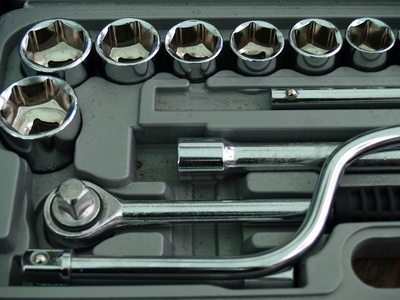
Rebuilding a transmission is no easy feat. It requires attention to detail, patience and the proper tools. An experienced transmission mechanic can easily rebuild a transmission in his own garage, provided he has the proper tools readily at hand. The transmission is underneath the vehicle, either behind the engine or underneath the engine, depending on the whether the vehicle is front-wheel or rear-wheel drive. The transmission must be removed and then it must be taken apart, the problem fixed and then reassembled. Depending on the model of the transmission, more tools may be necessary to get the job done, but most transmission rebuilds require some basic tools.
Impact wrenches are the workhorse of any technician. The wrenches are used for 80 percent of the work. The wrench's primary function is driving sockets. The most common size is a 3/8-inch drive, versatile enough to use for some precision work but tough enough for some heavy-duty tasks. Impact wrenches drive sockets, which in turn drive bolts that hold the transmission together. An air drill's only function is drilling holes through various types of material, such as aluminum, steel and magnesium. These metals are very common in transmission repair. The most common use of the air drill is for modifying the transmission separator plate. Blow guns shoot pressurized air to blow away debris, clean surfaces and dry moisture on metal surfaces.
There are dozens of different sockets. The most commonly used is the six-pointed socket. Transmission repair frequently requires specialty sockets, such as torx bit sockets, to complete a certain task. Torx bit sockets are six-pointed, non-inverted drivers. All sockets listed come in metric and standard sizes, except for torx bit sockets. Other sockets commonly used in transmission repair are the 12-pointed socket and the allen head socket. Wobble head sockets, which are six-pointed sockets with a 30 degree bend, are crucial for getting into the tight spaces frequently encountered in transmission repair.
The different styles of wrenches available are as vast as the different styles of sockets. For transmission repair, the combination wrench is the tool of choice. The combination wrench has a 12-pointed driver on one end and an open head driver on the other end. A variety of short and standard length wrenches, both metric and standard size, make the job of repairing a transmission easier, but the combination wrench is the most important. Wrenches are used to drive bolts.
Flat-head screwdrivers, in various lengths and sizes, are used for prying in transmission repair. The machinist hammer, or ball-peen hammer, in varying weights is also used in transmission repair work.
Regular pliers, snap ring pliers and needle nose pliers are used frequently in transmission repair. Regular pliers have short, stubby heads with wide jaws for grabbing on to various transmission parts. Needle nose pliers have a long, needle-shaped head with narrow jaws. They are ideal for getting into tight spaces. Snap ring pliers are a spring-loaded specialty tool designed specifically for compressing snap rings, which are found in transmissions. These three pairs of pliers form the most basic set you will need for transmission repair.